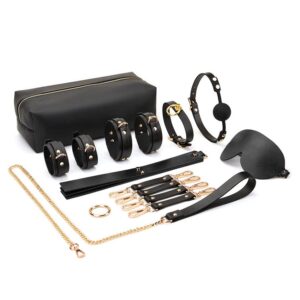Are you curious about the intriguing concept of Soft Dom? What sets it apart from conventional dominant-submissive relationships, and how can it add depth and intensity to your experiences? In this detailed guide, we’ll delve into the world of Soft Dom and provide answers to these questions, equipping you with valuable insights into this tender, emotionally rich, and consensual BDSM style. Whether you’re new to BDSM or an experienced practitioner, let’s explore the nuances of Soft Domination together.
Contents
ToggleWhat is a Soft Dom?
Picture this: you’ve ventured into the intriguing realm of BDSM, exploring the diverse flavors of power dynamics and submission. Amid this exploration, you’ve heard the term “Soft Dom” whispered within the community, but what exactly does it entail?
A Soft Dom, often known as a Gentle Dom or a Sensual Dom, brings a different shade of dominance to BDSM relationships. Unlike the stereotypical portrayal of dominating figures, a Soft Dom places emphasis on tenderness, emotional connection, and a profound understanding of their submissive partner’s needs and desires. They’re the artists of consensual power exchange, mastering the delicate balance between control and compassion.
The Traits and Characteristics of a Soft Dominant
Soft Dominants, often abbreviated as Soft Doms, bring a unique and cherished dynamic to the world of BDSM. Their distinctive blend of dominance, sensuality, and empathy sets them apart. Let’s take a closer look at the key traits and characteristics that define these remarkable individuals:
Empathetic: Soft Doms excel in empathy. They are highly attuned to their submissive partner’s emotional state, making their BDSM experiences not just physical but profoundly emotional.
Gentle Guidance: Instead of commanding, Soft Doms prefer to gently guide their submissives. They prioritize creating a nurturing environment where trust and intimacy can flourish.
Sensual: Sensuality is the heartbeat of Soft Domination. They cherish the tactile sensations, erotic communication, and intimate connection that BDSM can provide.
Communication Masters: Soft Doms are experts in open and honest communication. They value consent and active dialogue to ensure their submissive’s desires and boundaries are always respected.
Trust Builders: Building trust is at the core of a Soft Dom’s journey. They understand that trust is earned through consistency, respect, and unwavering support.
Patient: Soft Doms are patient teachers. They’re willing to explore their submissive’s desires at a pace comfortable for everyone involved.
Caring and Nurturing: They express their dominance through caring for their submissive partner. Acts of service, verbal affirmations, and gentle guidance are their tools of choice.
Adaptable: Soft Doms are flexible and adaptable to their partner’s ever-evolving needs and desires. They’re open to exploring new experiences while ensuring safety and consent.
Respectful: Mutual respect is non-negotiable for Soft Doms. They treat their submissives with the utmost respect, acknowledging their autonomy and value.
Emotional Connection: Soft Doms value the profound emotional connection they share with their submissives. This connection adds depth and meaning to their BDSM experiences.
Non-judgmental: They create a safe space for their submissives to express their fantasies and desires without judgment. Open-mindedness is a cornerstone of their approach.
Loving and Affectionate: Love is a fundamental element of Soft Domination. They express love and affection through their words and actions, nurturing a sense of safety and care.
Attentive to Limits: Soft Doms pay close attention to the limits and boundaries set by their submissives, ensuring that they are always respected.
Appreciative: They appreciate their submissive’s trust and vulnerability, making them feel valued and cherished.

Do you want to show your kinky side in casual outfits? We got you covered! Visit msoulart.com and find our Visit chokers, harnesses, and bodystockings. Now, let’s get back to reading
Soft Dom Sweet Nothings: Words That Ignite Desire
Communication is an art form, and Soft Doms are masters at using words to build trust, ignite passion, and create intimacy. Here’s a list of some things a Soft Dom might say to their submissive to intensify the connection and enhance the experience:
“You’re safe with me.”
“Your pleasure is my priority.”
“Tell me your fantasies; they’re our secrets.”
“I love watching you surrender.”
“You are so incredibly strong.”
“I’m here to guide, protect, and cherish you.”
“Your vulnerability is a precious gift.”
“Trust that I’ll always respect your boundaries.”
“I’m proud of your journey and growth.”
“Your submission is a beautiful work of art.”
“Let go; I’ll catch you.”
“Your desires are my desires.”
“Breathe, relax, and surrender to me.”
“I value and adore you.”
“Sensations are our playground; let’s explore.”
“You are my muse, my masterpiece.”
“Your pleasure is my aphrodisiac.”
“Consent is everything; your ‘no’ is sacred.”
“I admire your strength, vulnerability, and beauty.”
“Our connection is a dance of trust and passion.”
These phrases reflect the nurturing and caring nature of a Soft Dom, fostering an atmosphere of consent, trust, and profound emotional connection within the BDSM relationship.

Soft Dom vs. Traditional Dom
Soft Doms and Traditional Doms represent two distinct styles of dominance in BDSM. Each approach caters to different desires and dynamics within the BDSM community.
| Dimension | Soft Dom | Traditional Dom |
|---|---|---|
| Communication Styles | Emphasizes open, empathetic, and transparent communication. Prioritizes understanding the submissive's needs and boundaries through dialogue. | May employ a more authoritative communication style, focusing on obedience and compliance without extensive emotional conversations. |
| Approach to Control | Exerts control with a gentler touch, often using positive reinforcement and nurturing to guide the submissive. The emphasis is on ensuring the submissive's comfort and well-being. | Exerts control with a firmer hand, using rules, punishments, and discipline to maintain dominance. Prioritizes discipline and submission. |
| Physical Play | Tends to engage in softer, less intense physical play, focusing on sensations, and sensual experiences. May include light impact play, bondage, or sensation play. | May engage in more intense physical play, including practices such as impact play, bondage, and various forms of sensation play, which can be physically demanding. |
| Emotional Connection | Prioritizes building a strong emotional connection with the submissive. Focuses on nurturing trust, intimacy, and mutual well-being. | While emotional connection is important, the primary focus may be on power exchange and obedience. |
| Roles and Scenarios | Often engages in caring and protective roles, such as caregiver or mentor. Scenarios may involve gentle role-play, nurturing, and aftercare. | Typically embraces more dominant roles, such as master, mistress, or sadist. Scenarios may include stricter role-play and punishment dynamics. |
| Submissive Experience | Aims to create a safe and nurturing environment where the submissive can explore their desires and emotions. The experience is often more emotionally intense and fulfilling. | Focuses on the submissive's obedience and fulfillment of the Dom's desires. The experience may be more physically intense. |
| Consent and Boundaries | Places a strong emphasis on obtaining informed and enthusiastic consent for all activities. Respects the submissive's boundaries. | Requires consent but may explore activities with a greater focus on pushing boundaries within negotiated limits. |
The Heart of Soft Domination: Emotional Connection
Soft Doms stand out for their unwavering commitment to fostering emotional connections. This emphasis on emotional bonding and care sets them apart from other Dominant archetypes. Here, we delve into the pivotal role of emotional connection in Soft Domination:
Trust and Vulnerability: Soft Doms recognize that trust is the cornerstone of any BDSM dynamic. They prioritize creating an environment where their submissives feel safe to be vulnerable. This trust allows for deeper emotional connections to flourish.
Open Communication: Effective communication is key to nurturing emotional connections. Soft Doms excel in active listening, encouraging their submissives to express their thoughts, feelings, desires, and boundaries. This open dialogue builds mutual understanding and trust.
Care and Empathy: Soft Doms genuinely care about the well-being of their submissives. They approach BDSM with empathy, acknowledging that their submissives are real people with emotions and needs. This care extends beyond play sessions to everyday life.
Emotional Fulfillment: Soft Doms derive immense satisfaction from fulfilling their submissives emotionally. They understand that BDSM is not just about physical sensations but also about creating meaningful experiences that cater to the submissive’s emotional desires.
Creating Intimacy: Intimacy in a BDSM context is about more than just physical closeness. Soft Doms excel at creating emotional intimacy, allowing their submissives to feel deeply connected. This connection can lead to profound and transformative experiences.
Building Confidence: Through emotional connection and care, Soft Doms can boost their submissives’ self-esteem and confidence. The knowledge that their Dominant values and respects them empowers submissives to explore their desires.
Supportive Aftercare: Aftercare in Soft Domination is a deeply emotional experience. Soft Doms provide emotional support and comfort to their submissives, ensuring they feel secure and cared for after a BDSM session. This aftercare can be a time for reflection and connection.
Nurturing Growth: Soft Doms often act as mentors or caregivers, nurturing the personal growth of their submissives. They guide their submissives through their BDSM journeys, helping them explore their desires and develop as individuals.
Honoring Boundaries: Respecting boundaries is a crucial aspect of emotional connection. Soft Doms are diligent in ensuring they do not breach their submissives’ emotional boundaries, fostering an atmosphere of mutual trust and respect.
Celebrating Emotional Intimacy: Soft Doms view emotional intimacy as a source of great pleasure. They cherish the emotional bonds they share with their submissives and understand that these connections can be just as fulfilling as physical play.
Soft Doms understand that the emotional aspect of BDSM is just as vital as the physical. They create spaces where trust, care, and emotional fulfillment are nurtured. For those who value emotional connection and intimacy in their BDSM dynamics, Soft Domination offers a unique and rewarding experience.
-
29.99$
-
29.99$
-
24.99$
Boundaries and Limits in Soft Domination
In Soft Domination, respecting boundaries and limits takes center stage as an essential aspect of fostering a safe and emotionally fulfilling BDSM experience.
Boundaries as Pillars: Soft Doms understand that boundaries form the foundational pillars of a BDSM dynamic. They prioritize the importance of clearly defined boundaries to ensure that both Dominant and submissive are comfortable and safe.
Ongoing Communication: Effective communication is the lifeblood of Soft Domination. Soft Doms actively engage in conversations with their submissives, openly discussing their boundaries and desires. They create a safe space where submissives can voice their needs.
Negotiating Limits: The negotiation of limits is a key element before any BDSM play. Soft Doms discuss and agree upon activities, intensity levels, and emotional triggers. This process is characterized by patience and understanding, ensuring that both parties are on the same page.
Informed Consent: In Soft Domination, consent goes beyond a mere formality. It’s an ongoing process where both the Dominant and submissive are fully informed about what might happen during a scene. This understanding allows for enthusiastic, informed consent.
Safe Words and Signals: Soft Doms are diligent about implementing safe words and signals. These mechanisms provide submissives with a means to communicate their boundaries and discomfort during a scene. Soft Doms respond to these cues promptly and with care.
Respecting Emotional Boundaries: Emotional boundaries are as crucial as physical ones in Soft Domination. Soft Doms understand the need to respect their submissives’ emotional limits, ensuring they feel emotionally secure and valued.
Flexibility and Adaptation: Soft Doms remain flexible and adaptable to the changing emotional states of their submissives. They are attuned to cues of discomfort or unease and adjust their actions accordingly, fostering a trusting and emotionally safe environment.
Negotiated Scenes: Scenes in Soft Domination are often highly negotiated. Soft Doms take time to discuss each element of a scene in advance, ensuring it aligns with the submissive’s boundaries and emotional comfort levels.
Aftercare for Emotional Well-Being: The aftercare provided by Soft Doms extends to emotional care as well. After a scene, Soft Doms offer support, reassurance, and comfort to their submissives, helping them process their emotions and reinforcing the emotional connection.
Redefining Boundaries: Soft Doms understand that boundaries can evolve over time. They encourage ongoing discussions to redefine boundaries and limits as the BDSM relationship develops, ensuring the emotional well-being of all parties involved.
Aftercare in Soft Domination: Nurturing and Reassuring Emotional Well-Being
Aftercare is not just a ritual in soft dom; it’s a cherished practice that underscores the Dom’s commitment to their submissive’s emotional well-being. Aftercare is the bridge between the intense BDSM scene and the return to normalcy.
After a BDSM scene, Soft Doms offer emotional reassurance to their submissives. They understand that the submissive may experience a whirlwind of emotions, and they are there to provide comfort, understanding, and a non-judgmental space for the submissive to express themselves.
Soft Doms also recognize the physical toll a scene can take. They provide warmth, physical affection, and tenderness, whether through cuddling, gentle massages, or simply holding the submissive to create a sense of safety and security. Soft Doms encourage their submissives to share their feelings, thoughts, and experiences during the scene. This dialogue allows the Dom to better understand the submissive’s emotional state.
Soft Doms ensure that the submissive is mentally and emotionally prepared to re-enter the everyday world, offering guidance and support during this process. They pay attention to any signs of distress, discomfort, or emotional turbulence, and they use this feedback to fine-tune their future interactions and scenes. Aftercare reinforces the bond of trust between a Soft Dom and their submissive. By being attentive and responsive to the submissive’s emotional needs, the Dom deepens the trust and connection, strengthening the foundation of their BDSM relationship.
-
29.99$
-
118.99$
-
119.99$
-
113.99$
Types of Play in Soft Domination: Exploring the Gentle World of BDSM
Soft Domination embraces a gentler and more nurturing approach to BDSM, which naturally extends to the types of play involved.
- Sensory Play: Sensory play involves the use of various stimuli to elicit sensory responses. Soft Doms may employ techniques such as blindfolding, using feathers, silk scarves, or ice to stimulate their submissive’s senses gently.
- Bondage: While bondage is a fundamental element of BDSM, SoftDoms utilize it in a more comforting and less restrictive manner. Submissives may be bound with softer restraints, such as silk ties, and the focus is on the emotional connection rather than strict immobilization.
- Light Impact Play: SoftDoms may engage in light impact play, like gentle spanking or flogging, focusing on the pleasurable sensation rather than intense pain.
- Role-Play: Soft Domination often involves nurturing role-play scenarios, like caregiver/little, where the Dom provides emotional support and care to the submissive.
- Temperature Play: This type of play includes using hot wax or ice to provide sensual and comforting sensations rather than intense temperature-related pain.
- Massage and Body Worship: Soft Doms frequently incorporate sensual massages and body worship sessions into their play, allowing submissives to feel cherished and adored.
- Erotic Games: Soft Doms engage in erotic games that foster emotional intimacy and connection rather than intense power dynamics. These games are designed to build trust and love between Dom and submissive.
- Fetish Exploration: Soft Domination may involve the exploration of fetishes in a less intimidating and more supportive environment. The focus is on understanding and accommodating the submissive’s desires.
- Verbal Affirmation: SoftDoms use verbal communication to provide comfort and affirmation. They engage in intimate dialogues that boost their submissive’s confidence and self-esteem.
- Guided Meditation: Some SoftDoms incorporate guided meditation and relaxation techniques to create a calming and nurturing environment during BDSM play.
- Emotional Bondage: In Soft Domination, emotional bondage plays a pivotal role, focusing on the deep emotional connection between the Dom and the submissive. It may involve discussions, journaling, or other forms of emotional expression.
- Trust Building: Trust-building exercises, such as trust falls or verbal affirmations, are integrated into play to strengthen the emotional connection and sense of security.
- Romantic Play: Soft Doms may incorporate romantic activities, like sharing a candlelit dinner or exchanging love letters, into their BDSM dynamic.
- Intimate Communication: Communication and emotional bonding are considered a type of play, where Dom and submissive engage in open, honest, and nurturing dialogues that strengthen their connection.
- Age Play: In some Soft Dom dynamics, age play is explored, emphasizing the emotional nurturing and protection provided by the Dom in a caregiver role.
- Self-Care Practices: Soft Doms encourage their submissives to engage in self-care practices, like bubble baths, reading, or hobbies, as a form of play that focuses on self-love and well-being.
Examples of "Soft" Punishments in Soft Domination
Soft Domination emphasizes nurturing, growth, and emotional well-being rather than strict discipline or physical pain. As a Soft Dom, it’s essential to choose punishments that align with these principles.
Time-Outs: Encourage your submissive to take a short break to reflect on their behavior. Time-outs provide an opportunity for self-reflection and are effective for addressing minor issues.
Writing Assignments: Assign your submissive tasks that involve self-reflection or self-improvement. For example, they could write about what led to the misbehavior, their feelings, and their goals for personal growth.
Loss of Privileges: Temporarily restrict certain privileges, such as using specific devices or engaging in particular activities. Ensure that the restrictions align with the issue at hand.
Lines or Mantras: Ask your submissive to write lines or repeat mantras that emphasize positive behavior or personal growth. This can be a gentle way to reinforce their commitment to improvement.
Apologies: Request a written or verbal apology from your submissive to acknowledge their behavior and express their intent to do better.
Discussion and Reflection: Engage in open discussions about the issue and its underlying causes. Encourage your submissive to reflect on their actions and emotions.
Self-Improvement Tasks: Assign tasks that contribute to your submissive’s personal growth, such as reading self-help books, practicing mindfulness, or setting and achieving emotional goals.
Service Tasks: Encourage acts of service, such as preparing a special meal or performing a chore. This can help your submissive express their commitment to growth and connection.
Restricted Contact: Temporarily limit communication or physical contact as a way of emphasizing the importance of emotional connection and behavior correction.
Positive Reinforcement: Use praise and rewards to reinforce positive behavior. Acknowledge and reward your submissive when they exhibit the desired conduct.
Restrictions on Play: If a particular type of BDSM play led to the issue, temporarily restrict that activity until you’re both comfortable reintroducing it.
Grounding: For minor issues, consider grounding your submissive for a specified period. During this time, they can focus on self-improvement and emotional connection.
Reminder Symbols: Implement symbols or tokens that serve as reminders of your submissive’s commitment to growth. For example, a bracelet or pendant could be worn as a reminder of their progress.
Loss of Prerogatives: Temporarily suspend specific prerogatives to emphasize personal growth and the importance of following established boundaries.
Affirmations: Ask your submissive to write or recite affirmations that emphasize their commitment to emotional development and growth.
Journaling: Encourage your submissive to keep a journal where they can record their thoughts, feelings, and progress in their Soft Domination journey.
Sensory Deprivation: Mild sensory deprivation activities, such as blindfolding, can help your submissive focus on their emotional journey and reinforce their connection with you.
Delayed Gratification: In situations where immediate rewards may not be appropriate, encourage delayed gratification to teach patience and self-control.
These “soft” punishments are designed to promote personal growth, emotional connection, and improved behavior. They should always be implemented within the framework of open communication, trust, and mutual consent, reinforcing the nurturing principles of Soft Domination.
-
Rated 4.71 out of 5
129.99$Original price was: 129.99$.89.00$Current price is: 89.00$. -
Rated 5.00 out of 5
39.99$Original price was: 39.99$.29.99$Current price is: 29.99$. -
21.99$
-
155.99$Original price was: 155.99$.129.99$Current price is: 129.99$.
Examples of Positive Reinforcement in Soft Domination
Positive reinforcement is a fundamental aspect of Soft Domination, emphasizing the nurturing and rewarding of desired behaviors.
Verbal Praise: Offer verbal praise and compliments when your submissive exhibits the desired behavior or follows your guidance. Express appreciation for their efforts and progress.
Physical Affection: Provide physical affection such as cuddling, hugging, or kissing to reinforce the emotional connection between you and your submissive. These gestures convey care and affection.
Quality Time: Spend quality time together engaging in activities that your submissive enjoys. This reinforces the bond between you and allows you to nurture the relationship.
Gifts or Tokens: Give small gifts or tokens of appreciation to celebrate milestones or achievements in your Soft Domination journey. These gifts can hold sentimental value.
Custom Rewards: Create customized rewards tailored to your submissive’s preferences and interests. This shows that you understand and value their desires.
Positive Affirmations: Offer positive affirmations or mantras that focus on your submissive’s growth and progress. Reiterate your support and belief in their journey.
Permission for Pleasure: Grant your submissive permission to enjoy pleasurable activities or experiences as a reward for their positive behavior. This reinforces their connection with you as a source of pleasure and guidance.
Play and Exploration: Engage in enjoyable BDSM play or exploration together, celebrating their progress and commitment to Soft Domination.
Open Communication: Encourage open and honest communication about feelings and experiences. Create a safe space for your submissive to express themselves.
Relaxation and Pampering: Offer relaxation sessions or pampering activities to help your submissive unwind and feel cared for.
Acknowledgment of Progress: Frequently acknowledge the progress your submissive is making in their personal growth and Soft Domination journey.
Emotional Support: Provide emotional support and reassurance when your submissive faces challenges or self-doubt. Show empathy and understanding.
Surprise Rewards: Occasionally surprise your submissive with unexpected rewards to express your appreciation for their efforts.
Non-Sexual Intimacy: Engage in non-sexual intimate activities such as deep conversations, sharing secrets, or simply enjoying each other’s presence.
Freedom and Choice: Allow your submissive more freedom or choices within defined boundaries as a reward for their compliance and commitment.
Self-Care Encouragement: Support your submissive’s self-care routines and activities that contribute to their emotional and physical well-being.
Milestone Celebrations: Celebrate milestones in your Soft Domination journey with special events, outings, or experiences.
Goal Achievement: Encourage and celebrate the achievement of specific goals or tasks related to personal growth and improvement.
Written Acknowledgment: Provide a written acknowledgment of your submissive’s progress and the positive impact they have on your relationship.
Affectionate Gestures: Use affectionate gestures like holding hands, forehead kisses, or caressing to reinforce your connection and affection.
Role Outside the Bedroom in Soft Domination
In Soft Domination, the nurturing and caring approach extends beyond the bedroom and BDSM scenes. It’s a fundamental aspect of the dominant’s role to maintain this attitude in everyday life and interactions.
Communication and Check-Ins: SoftDoms maintain open communication with their submissives even in non-BDSM contexts. Regular check-ins allow both partners to express their feelings, needs, and concerns.
Respect for Boundaries: Respecting established boundaries is not limited to BDSM activities. SoftDoms ensure they honor their submissive’s limits in all aspects of the relationship.
Emotional Support: Soft Doms provide emotional support outside the bedroom, offering a safe space for their submissives to share their emotions and concerns. They offer guidance and reassurance when needed.
Personal Growth: Encouraging personal growth doesn’t stop in the bedroom. SoftDoms continue to support their submissives’ journeys towards self-improvement, offering guidance and motivation.
Quality Time: Spending quality time together remains essential. SoftDoms engage in non-BDSM activities that their submissives enjoy, fostering a deeper emotional connection.
Affection and Nurturing: Affectionate gestures and nurturing behavior persist in daily interactions. Holding hands, cuddling, or simply showing physical and emotional affection reinforces the bond.
Problem-Solving: Soft Doms assist in problem-solving and decision-making, providing guidance while respecting their submissive’s autonomy.
Daily Rituals: Incorporating daily rituals into the relationship helps maintain the nurturing dynamic. These can be as simple as morning texts or bedtime discussions.
Surprise Acts of Kindness: SoftDoms surprise their submissives with acts of kindness, showing appreciation and care outside BDSM scenes.
Freedom and Independence: While Soft Doms provide guidance, they also respect their submissives’ freedom and independence. They encourage self-expression and decision-making.
Planning and Organization: Soft Doms often take on the role of planning and organizing activities, ensuring that their submissives feel taken care of and cherished.
Collaborative Decision-Making: In everyday life, Soft Doms collaborate with their submissives to make important decisions, fostering a sense of equality and partnership.
Shared Interests: Exploring shared interests and hobbies is a way for SoftDoms and submissives to connect and bond outside of BDSM activities.
Celebrating Achievements: Soft Doms celebrate their submissive’s personal and professional achievements, showing pride in their successes.
Comfort and Security: Maintaining a safe and secure environment is a priority for SoftDoms. They ensure their submissives feel comfortable in the relationship.
Appreciation and Gratitude: Expressing appreciation and gratitude for their submissive’s presence and contributions to the relationship is a consistent practice.
Respect and Empathy: Soft Doms display respect and empathy in all interactions, valuing their submissives’ feelings and opinions.
Balance in Power Dynamics: Even in everyday situations, SoftDoms maintain a balanced power dynamic that respects the roles and responsibilities of both partners.
Adaptability: SoftDoms adapt to their submissive’s changing needs and preferences, ensuring the relationship remains fulfilling and nurturing.
Confidentiality: Maintaining the trust and confidentiality of their submissives’ personal information and experiences is paramount.
The role of a Soft Dom extends far beyond the bedroom, emphasizing the importance of a nurturing, caring, and respectful dynamic in all aspects of the relationship. This approach creates a deep emotional connection and a strong sense of security and trust between partners.
-
Rated 5.00 out of 5
21.99$Original price was: 21.99$.19.00$Current price is: 19.00$. -
119.99$
-
59.99$ – 69.99$
-
18.99$
How to be a Soft Dom?
Becoming a Soft Dom is a journey that involves embracing a style of dominance that prioritizes emotional connection, support, and nurturing. Here are some steps and tips to help you explore this nurturing approach to BDSM:
- Self-Exploration: Start by understanding your own desires and motivations for becoming a Soft Dom. Reflect on your need to provide emotional support and care within BDSM dynamics.
- Educate Yourself: Gain a deep understanding of BDSM, consent, and negotiation. Study the nuances of nurturing dominance, including aftercare and emotional connection.
- Communication Skills: Develop strong communication skills. Being able to listen actively and express your thoughts and feelings clearly is crucial in Soft Domination.
- Empathy: Cultivate empathy for your submissive’s emotional needs. Understand their desires, fears, and triggers, and strive to create a safe space for them to open up.
- Emotional Intelligence: Enhance your emotional intelligence by recognizing and managing your own emotions effectively. This skill will help you support your submissive more compassionately.
- Negotiation: Practice negotiation with a focus on emotional well-being. Encourage your submissive to express their emotional boundaries and expectations.
- Consent: Prioritize affirmative, enthusiastic consent in all activities. Ensure that both you and your submissive are comfortable with any proposed BDSM actions.
- Boundaries: Be aware of your own boundaries and respect your submissive’s limits. It’s important to maintain a balance between nurturing and respecting personal boundaries.
- Aftercare: Master the art of aftercare. Provide emotional support and physical comfort to your submissive after a scene. Understand their emotional needs and be there for them.
- Establish Trust: Build trust with your submissive through consistency, reliability, and genuine care. Trust is the foundation of any nurturing BDSM relationship.
- Create Emotional Connection: Focus on developing a deep emotional connection with your submissive. Learn about their past experiences, desires, and vulnerabilities to nurture their emotional well-being.
- Flexibility: Be adaptable and willing to adjust your approach based on your submissive’s emotional state and needs. Soft Domination is not rigid; it’s responsive and flexible.
- Self-Care: Don’t forget to take care of yourself. Being a SoftDom can be emotionally demanding, so make sure you have your own support system and self-care routines.
- Continuous Learning: BDSM is a constantly evolving practice. Keep learning and growing, and stay open to new ideas and experiences.
- Seek Guidance: Connect with other experienced SoftDoms or join BDSM communities where you can learn from others and share experiences.
- Respect: Always treat your submissive with respect and kindness. Soft Domination doesn’t mean being a pushover; it means providing emotional care and support while maintaining boundaries.
- Non-Judgmental Attitude: Approach your submissive without judgment. They should feel safe opening up about their emotional needs and desires without fear of criticism.
- Feedback: Encourage open feedback from your submissive. Regularly check in on their emotional well-being and ask for their thoughts on your nurturing style.
- Consent as a Process: Understand that consent is an ongoing process in Soft Domination. Continuously communicate with your submissive to ensure their emotional comfort.
- Patience and Practice: Becoming a SoftDom takes time and practice. Be patient with yourself and your submissive as you both learn and grow within this nurturing style of dominance.
Remember that Soft Domination is about creating a nurturing and emotionally fulfilling BDSM experience for both you and your submissive. By developing the skills and mindset of a Soft Dom, you can build deeply connected and satisfying BDSM relationships.
Unique Challenges Faced by Soft Doms in BDSM
Soft Domination, while nurturing and caring, comes with its own set of unique challenges that Dominants might encounter in BDSM dynamics.
Balancing Act: Soft Doms often walk a fine line between being nurturing and maintaining the power dynamic. Striking this balance can be challenging, as it requires a deep understanding of their submissive’s needs.
Negative Stereotypes: BDSM is often misunderstood or stereotyped, and this can also apply to Soft Domination. Addressing these stereotypes and misconceptions can be a persistent challenge.
Communication: Effective communication is vital, but it can be challenging to ensure that both partners fully understand each other’s needs and boundaries.
Vulnerability: SoftDoms may experience vulnerability, as they openly express care and affection in their BDSM relationships. This emotional openness can be challenging for some.
Scene Planning: Planning scenes that cater to a submissive’s needs while maintaining the nurturing aspect can be a complex task. SoftDoms need to be creative and attentive in this regard.
Educating Others: Explaining the dynamics of Soft Domination to those outside of the BDSM community or even within it can be challenging. SoftDoms often take on the role of educators.
Flexibility: Soft Doms may face the challenge of adapting to their submissive’s changing emotional and physical needs, requiring flexibility in their approach.
Boundaries: Understanding and respecting both the submissive’s and their own boundaries is crucial. Soft Doms need to navigate these boundaries skillfully.
Self-Care: Caring for oneself while providing emotional support and nurturing to a submissive can be challenging. SoftDoms must prioritize self-care to avoid burnout.
Intimacy and Emotional Connection: Building and maintaining deep emotional connections can be both rewarding and challenging. SoftDoms invest time and energy in fostering these connections.
Acceptance: Some Soft Doms may encounter resistance or judgment from others within the BDSM community who prefer more traditional Domination styles.
Rejection: The nurturing approach of SoftDoms may not align with every submissive’s desires, potentially leading to rejection by those seeking a different Domination style.
Protecting the Submissive: Ensuring the safety and emotional well-being of the submissive is a challenge that Soft Doms take seriously.
Respect for Authority: Some individuals may question the authority of SoftDoms, requiring them to assert their role while remaining nurturing.
FAQs
Soft Dom VS Hard Dom
Soft Doms and Hard Doms represent two distinct facets of BDSM dynamics, catering to various tastes and desires within the community. A SoftDom embodies a nurturing, emotionally-centered approach, prioritizing their submissive’s well-being and fostering a strong emotional connection. They engage in milder forms of BDSM, emphasizing consent, communication, and aftercare. In contrast, a Hard Dom embraces intensity, incorporating physical pain, humiliation, and strict discipline into their sessions, all while respecting the need for consent and aftercare. However, it’s important to note that these roles exist on a spectrum, allowing for a blend of styles to meet the unique preferences of each BDSM partnership. Ultimately, open communication, negotiation, and trust are fundamental in creating satisfying and consensual BDSM experiences.
Is It Possible to Switch Between Being a Soft Dom and a Hard Dom?
Yes, it is indeed possible for a Dominant in BDSM to switch between being a Soft Dom and a Hard Dom. Many individuals within the BDSM community have versatile Dominant personas and can adapt their approach depending on their submissive’s preferences and the nature of the scene. The ability to switch between these styles reflects flexibility and a deep understanding of the importance of communication and consent in BDSM dynamics. It allows for a more tailored and fulfilling experience for both the Dominant and the submissive, ensuring that their desires and boundaries are respected. Switching between these roles can add variety and excitement to BDSM relationships while prioritizing the well-being and satisfaction of all parties involved.
Is Soft Dom Lack of Dominance?
No, some may mistakenly believe that SoftDoms lack the assertiveness and control associated with BDSM Dominants. In reality, they express dominance in a more nurturing and gentle manner.
Are Soft Dom Weak?
Soft Doms are not weak; they use their nurturing qualities to dominate with compassion. Being nurturing does not equate to being submissive or passive.
Are Soft Doms Not as Effective in BDSM Dynamics as Hard Doms?
There’s a misconception that SoftDoms may not be as effective in BDSM dynamics as Hard Doms. However, they can elicit submission through emotional connection and care.
Do Soft Doms Only Engage in Light BDSM Activities?
Some believe that SoftDoms only engage in light BDSM activities, but they can participate in a wide range of BDSM scenes while maintaining their nurturing approach.
What is a Soft Daddy?
A “Soft Daddy” is a term used within the BDSM and age-play communities to describe a Dominant who takes on a nurturing and caring role, often resembling that of a parental figure, typically a fatherly one. This dynamic is characterized by the Dominant providing emotional support, guidance, and affection to their submissive, who may adopt a childlike or “little” persona. Soft Daddies emphasize creating a safe, loving, and protective environment for their submissives, focusing on their emotional well-being and personal growth. This type of BDSM dynamic often involves age regression, with the submissive adopting a younger mental or emotional age.
What is a BB daddy?
A “BB Daddy” is a colloquial term that typically stands for “Big Brother Daddy” or “Bear Brother Daddy” in certain subcultures of the LGBTQ+ community, particularly in the context of the bear and leather communities.
Final Words
In this extensive discussion of Soft Domination, we’ve explored what it means to be a SoftDom, their unique traits, characteristics, and approaches within the BDSM context. SoftDoms, with their nurturing and emotionally connected style, emphasize boundaries, consent, and aftercare while exploring various forms of play with their submissives. They provide crucial emotional support and maintain their nurturing role even outside the bedroom.
Understanding the key differences between Soft Doms and other Dominant archetypes, like Hard Doms or Pleasure Doms, helps clarify the diverse dynamics within BDSM relationships.
Remember, there’s no one-size-fits-all approach to BDSM, and individuals may evolve within these roles, embracing different aspects of their dominant personas. Open communication, consent, and mutual respect are fundamental in any BDSM relationship, ensuring that all parties find satisfaction, growth, and fulfillment within their chosen roles.








































